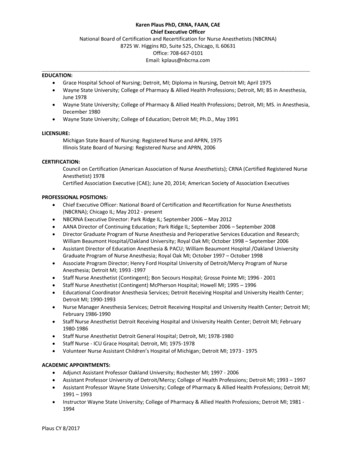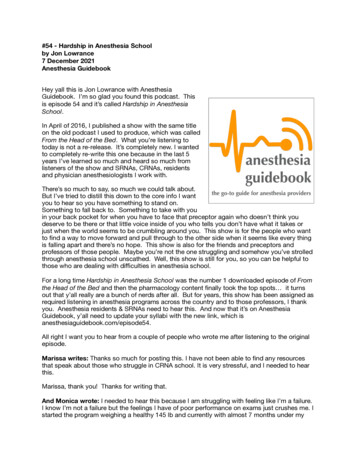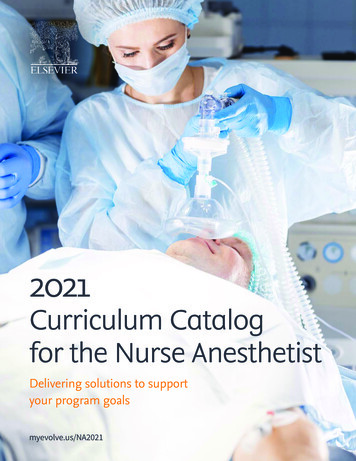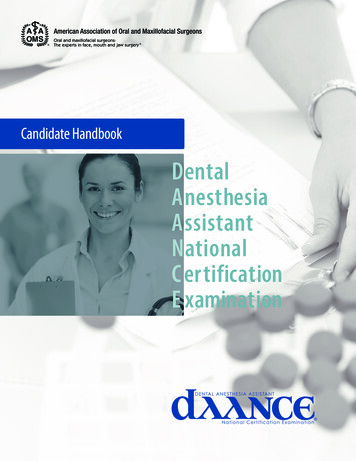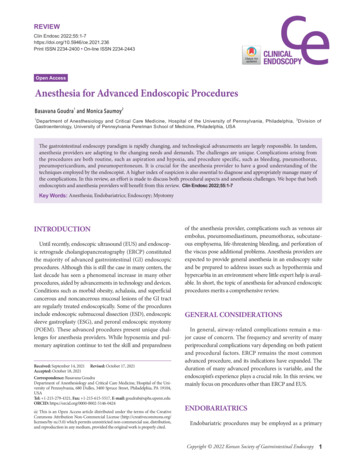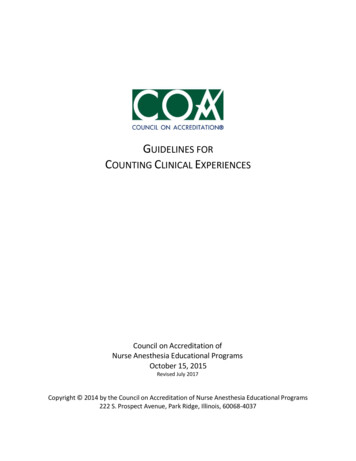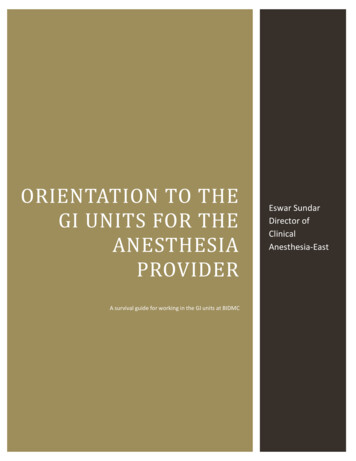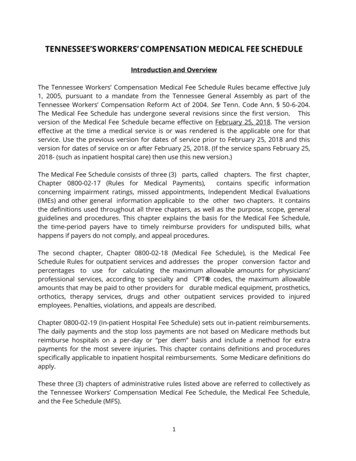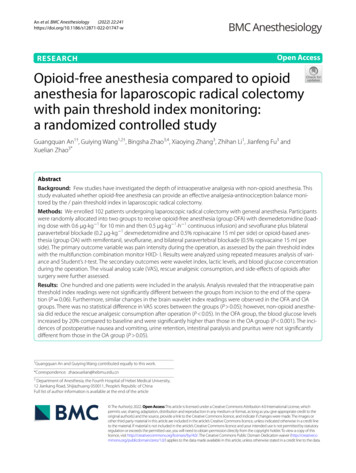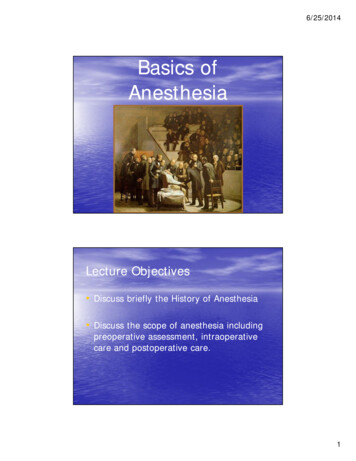
Transcription
6/25/2014Basics ofAnesthesiaLecture Objectives Discuss briefly the History of Anesthesia Discuss the scope of anesthesia includingpreoperative assessment, intraoperativecare and postoperative care.1
6/25/2014The History of Anesthesia The first successful anesthetic took place at Massachusetts General Hospitalin 1846 by a dentist, Dr. William T Morton. No significant new inhaled anesthetics were introduced during the next 80years. Cyclopropane, because of its low blood solubility and support of the circulation, became the most important new inhaled anesthetic in the1930’s.1930’s.Fluorinated inhaled anesthetics were used in the 19501950’s’s because of minimaldepression of cardiovascular function, less organ toxicity and low bloodsolubility.Presently, one gas (nitrous oxide) and the vapors of three volatile liquids(sevoflurane, desflurane & isoflurane) represent the commonly used inhaledanesthetics.Preoperative management Areas to investigate inpreop history. Previous adverseresponses related toanesthesia Allergic Reactions Sleep apnea Prolonged skeletal muscleparalysis Delayed awakening Nausea and vomiting Adverse responses in relatives Central NervousSystem Cerebrovascular insufficiency Seizures Cardiovascular System Exercise ToleranceAnginaPrior MIHTNClaudication2
6/25/2014 Lungs Exercise ToleranceDyspnea and OrthopneaCough and Sputum ProductionCigarette consumptionPneumoniaRecent upper resp. tractinfection Liver Alcohol ConsumptionHepatitis Endocrine System Diabetes mellitusThyroid gland dysfunctionAdrenal gland dysfunction Coagulation Bleeding tendencyEasy bruisingHereditary coagulopathies Kidneys NocturiaPyuria Skeletal and Muscular SystemsArthritisOsteoporosisWeakness Reproductive System Menstrual History STD’s Dentition DenturesCaps3
6/25/2014 Other important Info needed in History:History: Current Drug Therapy Neonatal Hx Previous Surgeries Physical Exam: CNS Level of Consciousness Evidence of peripheral, sensoryor skeletal muscle dysfxn CV Auscultation of heartSystemic blood pressurePeripheral pulsesVeinsPeripheral edema Lungs Auscultation of Lungs Pattern of breathing4
6/25/2014 Upper Airway Cervical spine mobilityTemporomandibular mobilityTracheal mobilityProminent central incisorsDiseased or artificial teethAbility to visualize uvulaThyromental distanceMallampati Classification Size of Tongue Versus Pharynx The size of the tongue versus the oral cavity can be visually gradedby assessing how much the pharynx is obscured by thetongue. This is the basis for the Mallampati Classification.5
6/25/2014Class I Soft palate,anterior andposterior tonsillar pillars anduvula visibleClass II Tonsillar pillars and base ofuvula hidden by base oftongue6
6/25/2014Class III Only soft palate visibleClass IV Soft palate not visible7
6/25/2014 What Laboratory tests are needed? Surgical patients require preop lab and diagnostic studies that areconsistent with their medical histories, the proposed operativeprocedures, and the potential for blood loss.Lab Test CXR Clinical indications Pneumonia, pulmonary edema, Atelectasis,mediastinal orpulmonary masses,pulm.HTN,cardiomegaly, AdvancedCOPD with blebs, PE ECG Hx of CAD,Age 50, HTN,chest pain, CHF, diabetes,PVD, SOB, DOE,palpitations,murmurs8
6/25/2014Lab test ClinicalIndications LFT Hx of Hepatitis, Cirrhosis, Renal fxn testing HTN, increased fluidLab Test CBC Clinical Indications Coagulation testing Pregnancy testingportal HTN, GB or biliarytract disease, Jaundiceoverload, diabetes,urinary problems, dialysispt’s Hematologic disorder,bleeding, malignancy,Chemo/radiation tx, renal ds.,highly invasive or trauma sx. Bleeding disorder hx.,Anticoagulant meds, Hepaticds. Sexually active, time of lastmenstrual period.9
6/25/2014Choice Of Anesthesia There are four main types ofanesthesia from which to choose: General anesthesiaProvides loss of consciousness and loss of sensation. Regional anesthesiaInvolves the injection of a local anesthetic to provide numbness,loss of pain or loss of sensation to a large region of the body.Regional anesthetic techniques include spinal blocks, epidural blocksand arm and leg blocks. Medications can be given that will make thept comfortable. Monitored anesthesia (MAC)Consists of medications to make you drowsy and torelieve pain. These medications supplement localanesthetic injections, which are often given by yoursurgeon. While you are sedated, your anesthesiologistwill monitor your vital body functions. Local anesthesiaNumbness to a small area, is often injected by yoursurgeon. In this case, there may be no anesthesia teammember with the patient.10
6/25/2014ASA Classification The American Society of Anesthesiologists’(ASA) physicalstatus classification serves as a guide, to allowcommunication among anesthesiologists about clinicalconditions of patients. A way to predict theiranesthetic/surgical risks -the higher ASA class, thehigher the risks. ASA Classification Class 1Healthy patient, no medical problems Class 2 Mild systemic disease Class 3Severe systemic disease, but not incapacitating Class 4 Severe systemic disease that is aconstant threat to life. Class 5 Moribund, not expected to live 24hours irrespective of operation. An E is added to the status number to designatean emergency operation. An organ donor is usually designated as Class 6.11
6/25/2014Intraoperative management Equipment Check Suction Airway Laryngoscope Tube Apply Standard ASA Monitors -Pulse ox, EKG, NIBP, precordial oresophageal stethoscope Put pt in optimal intubatingposition. Preoxygenate Induction - IV anesthetic(propofol), Narcotics, Musclerelaxant Mask ventilate12
6/25/2014 Intubate Check breath sounds, end tidalCO2, Blood pressure, HR, sats. Maintain on Inhalationagent. Patient positioning - protectpressure areas Intraop fluidmanagement Anesthesia record Vital signs monitoring13
6/25/2014 Indications for intubation:intubation: ·Uncorrectable hypoxemia (pO2(pO2 55 on 100100%% O2O2 · · ····NRB).Hypercapnia (pCO2(pCO2 5555)) with acidosis (pH 7(pH 7.2525););remember patients with COPD often live witha pCO2pCO2 5050-7070 without acidosis.Ineffective respiration (max inspiratory force 25cm H2H2O).Fatigue (tachypnea with increasing pCO2pCO2).Airway protection.Upper airway obstruction.Septic shock. Extubation criteria: pt responsive to simple commands Good muscle strength - hand grip, 5 sec head lift Hemodynamically stable Others: no inotropic support pt afebrile vital capacity 1515cc/kgcc/kg ABG reasonable with FiO2 4040%% (PaO2(PaO2 7070,, PaCO2PaCO2 5555))14
6/25/2014Postoperative management PACU Guidelines STANDARD IALL PATIENTS WHO HAVE RECEIVED GENERALANESTHESIA, REGIONAL ANESTHESIA OR MONITOREDANESTHESIA CARE SHALL RECEIVE APPROPRIATEPOSTANESTHESIA MANAGEMENT. STANDARD II A PATIENT TRANSPORTED TO THE PACU SHALL BE ACCOMPANIEDBY A MEMBER OF THE ANESTHESIA CARE TEAM WHO ISKNOWLEDGEABLE ABOUT THE PATIENT'S CONDITION. THEPATIENT SHALL BE CONTINUALLY EVALUATED AND TREATEDDURING TRANSPORT WITH MONITORING AND SUPPORTAPPROPRIATE TO THE PATIENT'S CONDITION.STANDARD IIIUPON ARRIVAL IN THE PACU, THE PATIENT SHALL BE RERE EVALUATED AND A VERBAL REPORT PROVIDED TO THERESPONSIBLE PACU NURSE BY THE MEMBER OF THE ANESTHESIACARE TEAM WHO ACCOMPANIES THE PATIENT15
6/25/2014 STANDARD IVTHE PATIENT'S CONDITION SHALL BE EVALUATED CONTINUALLYIN THE PACU. STANDARD VA PHYSICIAN IS RESPONSIBLE FOR THE DISCHARGE OF THEPATIENT FROM THE POSTANESTHESIA CARE UNIT.Discharge Criteria Post anesthetic discharge scoring (PADS) systemis a simple cumulative index that measures thepatient's home readiness. Five major criteria: (1) vital signs,signs, includingblood pressure, heart rate, respiratory rate, andtemperature; (2) ambulation and mentalstatus;; (3) pain and PONV;statusPONV; (4) surgicalbleeding; and (5) fluid intake/output. Patients who achieve a score of 9 or greater andhave an adult escort are considered fit fordischarge (or home ready).16
6/25/2014 Vital Signs:2 Within 20% of the preoperativevalue, 1 20%–20%–40% of the preoperative value, 0 40% of the preoperative value Ambulation:2 Steady gait/no dizziness 1 Withassistance 0 No ambulation/dizziness Nausea and Vomiting: 2 Minimal 1 Moderate0 Severe Pain: 2 Minimal 1 Moderate 0 Severe Surgical Bleeding: 2 Minimal 1 Moderate 0 Severe17
6/25/2014 2 The History of Anesthesia The first successful anesthetic took place at Massachusetts General Hospital in 1846 by a dentist, Dr. William T Morton. No significant new inhaled anesthetics were introduced during the next 80 years. Cyclopropane, because of its low blood solubility and support of the circulation, became the most important new inhaled anesthetic in the

